The decoy effect describes what happens when, while choosing between two items, a third item is introduced that causes you to switch your preference between the first two items.
A few weeks ago, I was at a clothing store trying to decide between two shirts. I liked the way one shirt fit, but I liked the pattern of the other one better.
The choice paralyzed me. I went back and forth between the two shirts, holding them up side-by-side, taking one to the cashier, then the other. The two shirts were equally good, and I was struggling to choose.
Then I noticed a third shirt. It was similar to the first shirt—the one that fit really well. But it was also twice as expensive.
I re-evaluated my first two options. One of them was similar to this new third option. The main difference was the price: it was half as expensive. That made it more appealing. I happily made my decision, got the shirt, and left a satisfied customer.
While I was driving home, I realized I had fallen for the decoy effect.
Here’s how:
The first two shirts had opposite qualities, but were equally good. The negatives and positives of each balanced each other out, like this:
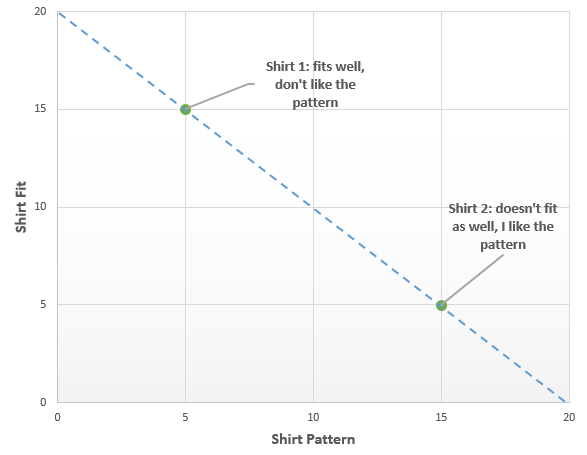
But once I saw a third shirt, it broke the symmetry. See how it’s not on the dashed line?
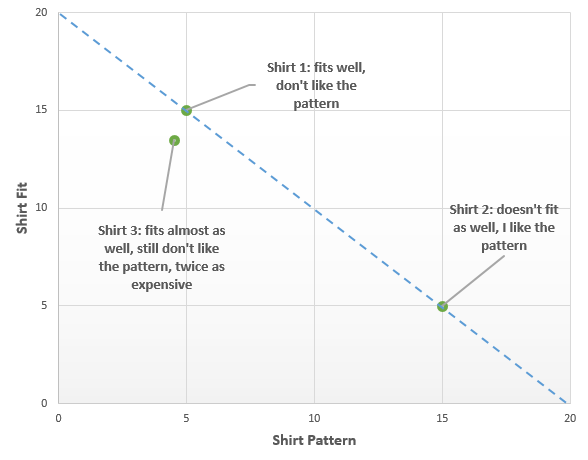
To put it more technically, the choice I made between these three shirts was asymmetrically dominated. The asymmetry of the third shirt reframed the choice. It shift the comparison from the first two shirts to the third shirt and the shirt of the first two most similar to it. This third option is called a decoy, and the process of a decoy influencing a decision is called the decoy effect.
The decoy effect is completely irrational:
- If you choose between two options: Item A is better than Item B
- If you choose between three options: Item B is better than Item A
This doesn’t make sense. if A is superior to B, then A should still be superior to B even if C is added.
Or: if you ask someone if they like dogs or cats more, and they say they like dogs best, then asking whether they like dogs, cats, or mice more shouldn’t make them say they like cats best. If dogs are better than cats when there are two options, dogs are still better than cats when there are three options.
| Question | Your answer |
| Do you like cats or dogs more? | Dogs |
| Do you like cats, dogs, or mice more? | Cats |
Yet when people make choices, they make this irrational switch all the time. What’s going on?
The most famous example of the decoy effect
A few years ago, MIT Professor Dan Ariely noticed something strange on The Economist subscription page. The magazine offered three subscription offers at the following prices:

Ariely did an experiment with his students. He split them into two groups:
- Group 1 was offered two options: a web-only subscription and a print + web subscription.
- Group 2 was offered all three options: a web-only subscription, a print-only subscription and a print + web subscription.
Here’s what each group chose:
- Group 1: when two options were presented: 68% of people chose web only, and 32% of people chose both print and web
- Group 2: when three options were presented: 16% chose web only, 0% chose print only, and 84% chose both.
| When two options presented | When three options presented | |
| Web only: $59 | 68% | 16% |
| Print only: $125 | Not shown | 0% |
| Web + print: $125 | 32% | 84% |
When he changed this from a 2-choice set to a 3-choice set, the least popular option became the most popular option.
In his TED talk, Ariely describes what happened:
“The option that was useless was useless in the sense that nobody wanted it. But it wasn’t useless in the sense that it helped people figure out what they wanted. . . . We actually don’t know our preferences that well, and because we don’t know our preferences that well, we’re susceptible to all the influences from external forces.”
The only function of the third option—the decoy—is to guide people toward the option most beneficial to the Economist, but not necessarily the most beneficial to the subscriber.
You encounter the decoy effect every day
But wait, you may be saying. The Economist example is so obvious. I would never fall for that.
Smartphones
If you’re thinking of buying an iPhone 8, then the existence of the iPhone X makes you more likely to buy the iPhone 8 Plus—even though in no case would you buy the iPhone X. Simply by adding a more expensive decoy, Apple has raised the average price paid for any iPhone from $694 to $796—not only by introducing a more expensive model, but by making the previous most expensive model the new midpoint.

Politics

A decoy can also affect your views on political figures.
While Barack Obama was in office, you may not have liked George W. Bush. But now that Donald Trump is in office, you probably like Bush a little more now. In neither case do you like Donald Trump. That’s because Trump is the decoy. Simply adding Donald Trump to the set doesn’t change your views of either Obama or Trump, but it may shift–or even reverse–your opinion of Bush.
Polling data bears this out. Bush’s approval ratings have steadily climbed since Trump took office. Even Democrats now view Bush favorably. Here is Will Ferrell’s parody of this phenomenon in an SNL sketch:
Airlines
Airlines have also introduced decoys. It’s likely that next time you book a ticket, you’ll be asked to choose from multiple fares.
Compare the fare for a one-way flight from Chicago to Orlando on United Airlines:

Many people—most recently popular airline blogger Brett Snyder—have criticized United for promoting Basic Economy as the cheapest option, when, in fact, after baggage fees are added and seats reserved, customers often pay more than a regular economy ticket.
While this is fair criticism, it misses the point of United’s pricing strategy. Basic Economy exists, in part, to change the choice architecture from deciding whether to buy a ticket than deciding between three tickets: an obviously inferior one and a far more sensible one. Basic Economy helps sell Economy tickets.
How, exactly, do decoys work? And what can we do about it?
Let’s take a look at exactly how the decoy effect shapes your choices, as well as four things you can do to prevent yourself from falling for it.
Here’s what we’ll cover:
- Some basic terminology: what are targets, competitors, and decoys?
- How decoys influence your choices
- A decoy changes how you value the target
- A decoy takes advantage of your desire to avoid loss
- A decoy makes it easier for you to justify a bad decision
- How your brain processes a decoy
- The 4 ways to avoid falling for the decoy effect
Let’s jump in.
In the next post, I’m going to tell you about one pricing tactic Starbucks uses to get you to spend more. It’s going to blow your mind.
Some basic terminology: what are targets, competitors, and decoys?
Decoys work best when there are three choices:
- The target is the choice someone else wants you to make—whether that’s a waiter, a real estate agent, a political strategist, or any person or group (or circumstance) responsible for setting up your choice options.
- The competitor is the option that’s up against the target.
- The decoy, when added, changes your choice from the competitor to the target.
Let’s visualize how these three choices look. We’re asked to choose two hypothetical iPhones, and we need to evaluate them on speed and battery life. In the 2-choice set below, it is difficult to choose, because there is a symmetric relationship between speed and battery life.
| Model | Speed | Battery Life |
| iPhone 1 (target) | 50 | 10 |
| iPhone 2 (competitor) | 35 | 15 |
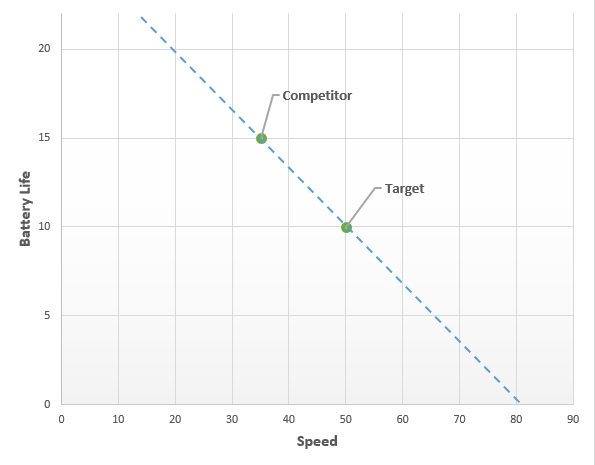
Now, let’s add a third item to the choice set. In this set, we still have our original two, but now the decoy is added.
| Model | Speed | Battery Life |
| iPhone 1 (target) | 50 | 10 |
| iPhone 2 (competitor) | 35 | 15 |
| iPhone 3 (decoy) | 50 | 8 |
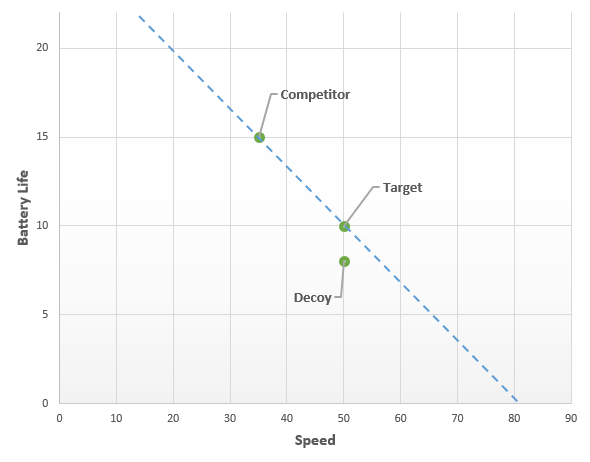
The difference between these two choices is important: in the 2-choice set, the choice is difficult. We waver between the two options: do we want more speed? Or more battery life? Wanting one requires a symmetrical tradeoff of the other.
But in the 3-choice set, the decoy reframes how we think about the decision. It forces us to focus on only one quality–battery life–instead of both qualities–battery life and price. And when we focus on battery life alone, we’re more likely to choose the target.
Moving the decoy around can change how we view the target. For example, decreasing the decoy’s speed so it’s equidistant between the target and the competitor still favors the target, but it makes the decision more difficult.
| Model | Speed | Battery Life |
| iPhone 1 (target) | 50 | 10 |
| iPhone 2 (competitor) | 35 | 15 |
| iPhone 3 (decoy) | 42.5 | 8 |
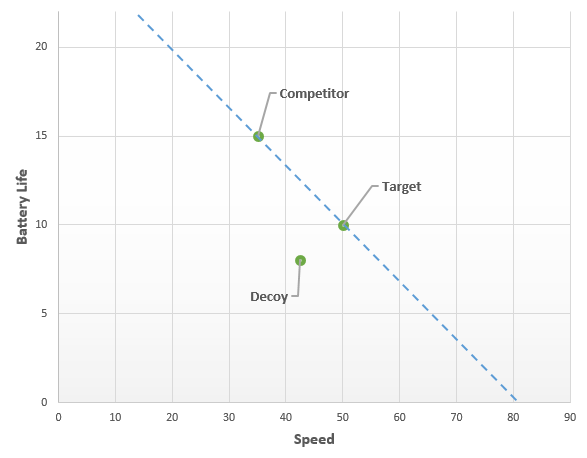
And moving the decoy slightly closer to the target still strongly favors the target with it being obvious to the consumer it’s a decoy:
| Model | Speed | Battery Life |
| iPhone 1 (target) | 50 | 10 |
| iPhone 2 (competitor) | 35 | 15 |
| iPhone 3 (decoy) | 46.25 | 8 |
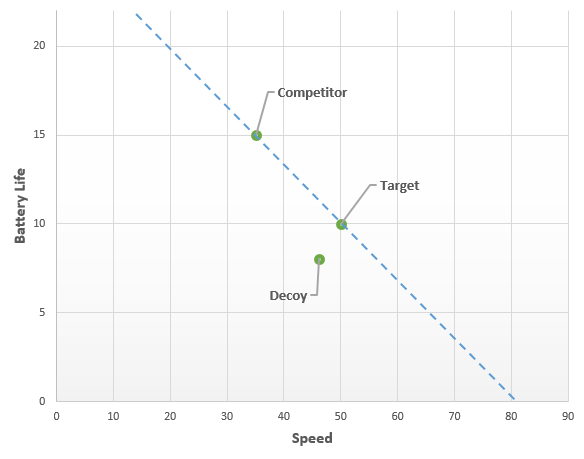
It’s even possible to calibrate the optimal position of a decoy in a choice set with ample user testing:
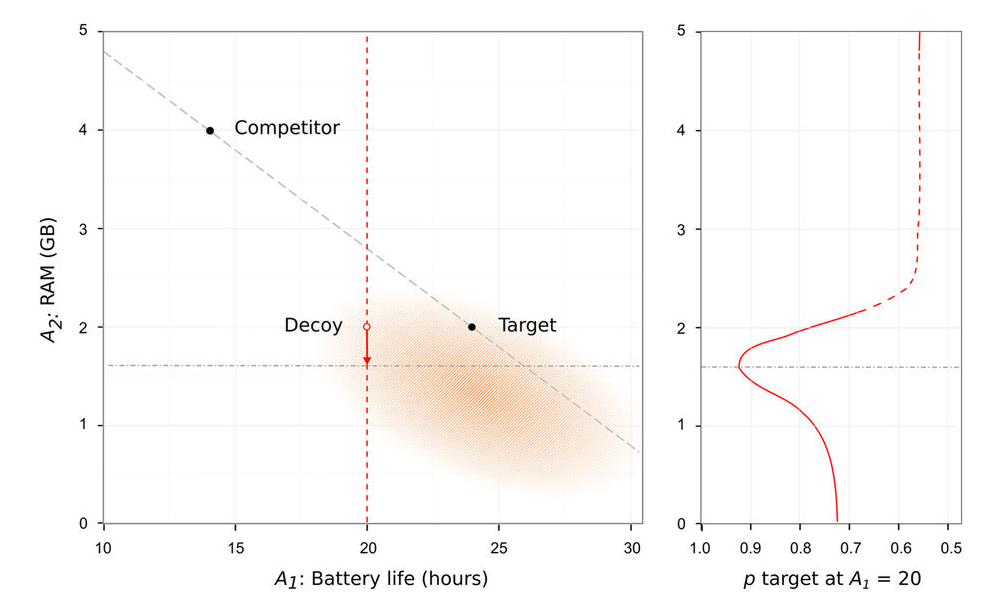
McDonald’s recently attempted to use the decoy effect to sell more chicken nuggets, but customers noticed the misplaced decoy:
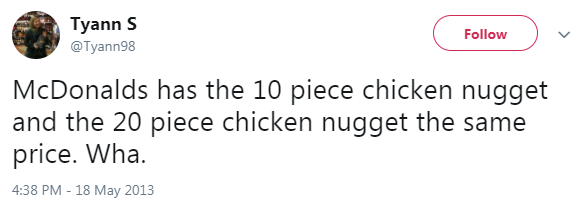
And some weren’t happy:
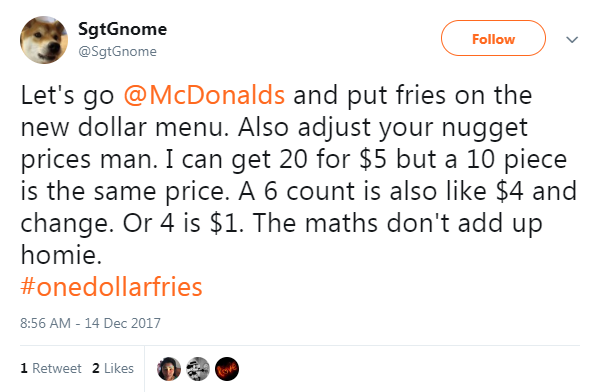

How decoys influence your choices
Now that we’ve got a basic understanding of what a decoy is, let’s take a step-by-step look at how decoys operate at a subconscious level.
A decoy changes how you value the target
Adding a decoy to a choice set literally changes the entire context by which you made a decision.
In the first-ever study of the decoy effect, people were asked to choose a beer based on the quality and the price.
| Price | Quality | |
| Target | $1.80 | 50 |
| Competitor | $2.60 | 70 |
| Decoy | $1.80 | 40 |
As expected, more people chose the target when the decoy was added: 63% with a decoy compared to 43% without. Adding a decoy made people more likely to judge the beer on quality only and forget about price.
But why?
It’s because increasing the range of one attribute but not the other affects how people make the decision.
With a decoy, the range of quality increases from 20 (50 to 70) to 30 (40 to 70). As a result, the beer’s quality get’s more attention than its price. The quality of the beer becomes the starting point, and price recedes into the background as a factor in the decision.
What if, instead of adding a third option with a lower quality, we add a third price?
| Price | Quality | |
| Target | $1.80 | 50 |
| Competitor | $2.60 | 70 |
| Decoy | $2.20 | 50 |
As you can probably guess, adding a third price draws attention away from the quality of the beer and focuses it on the price.
But something else happens, too. If this third price is between the two other prices, then it increases the psychological distance between the extremes in price. $2.60 feels more expensive. This makes you less likely to evaluate the competitor against the other two options, and more likely to evaluate the target against the decoy. And if you evaluate the target against the decoy, the only distinguishing factor is the price, which means you’ll choose the target.
Changing the range has another effect on your decision. You make choices by comparing the possible outcomes with the number and kinds of similar experiences you have had with those outcome in the past.
If you’re choosing between two beers, and the target is the worse beer, then the questions you might ask yourself are: What have been my experiences with bad beers in the past? How many of these experiences have I had, and how many have I enjoyed?
You don’t like to buy the worst item in a set not because of the product, but because of what it says about you: Would I settle for less? Am I the kind of person that likes the worst of a thing? Am I below average? If a retailer wants you to buy the most inexpensive product, then these are not the kinds of questions they want you asking about it.
But adding a decoy increases the range, which places the target nearer to the midpoint. Now, people ask themselves: What has been my experience with average beers in the past? How many of these experiences have I had, and how many have I enjoyed?
The decoy reframes the way you approach the decision by changing which attributes of the choices you focus on. Whereas without a decoy, you evaluate multiple product attributes at the same time, with a decoy, you’ll instead focus on only one attribute at a time. The way you evaluate that attribute will change. Instead of comparing attributes between products, you evaluate each product against your own identity and values. Instead of asking whether or not the product is inferior or superior for multiple attributes at once, you’ll now ask whether a product is superior or inferior on one attribute at a time. The decoy shifts a comparison among products to a consumer-product comparison: you’ll now ask: Am I the kind of person who likes inferior things? Is that the person I want to be?
In short, adding a decoy causes you to ask whether your choice brings you a step closer to your ideal version of yourself.
| Decision process | Primary Decision Factor | |
| Choice set without a decoy | Choice among products oriented around comparison of multiple attributes. | What choice gives me the best quality at a price I am willing to pay? |
| Choice set with a decoy | Compare a single attribute shared by two products with your own identity. | What does a choice based on this attribute say about me as a person? Or about the kind of person I wish I were? |
A decoy appeals to your desire to avoid loss
Decoys also appeal to an even more basic trait of human nature, a trait that underlies every irrational decision you’ll ever make: your aversion to loss.
Loss aversion means that $10 feels twice as expensive when it’s a loss instead of a gain. Several experiments have confirmed a loss aversion ratio of approximately 2:1. As a result, we are more likely to make a choice if it results in a comparably smaller amount of loss.
But the very definition of “loss” is subjective: a loss compared to what? All it takes is shifting the reference point to change a gain into a loss.
In a three-choice set with a decoy, the decoy serves as a non-neutral reference point—the point from which you compare advantages and disadvantages. By moving a decoy around, you can move the reference point by which you evaluate gains and losses between two products.

In the above example, y is technically equidistant between x and z. Each extreme option (x and z) has a large disadvantage relative to the other. If a decision is based on attribute 2, then, while x may be twice as good as z compared to y, the reverse is not true: z is more than twice as worse than y, because it constitutes a loss.
If a decision is based on attribute 1, then the opposite is true. While z may be twice as good as x, x is not twice as bad as y, because losses loom larger than gains.
The addition of y as a decoy–even though it is not asymmetrically dominated–serves to amplify gains and losses between a target and competitor.
But look what happens when the third item becomes asymmetrically dominated. Now the loss between x and y remains symmetrical, but the loss between y and z is now asymmetrically dominated:

Decoys play on our tendency to avoid loss in one other important way. When you choose between three items instead of two, you tend “to find the lowest quality more aversive than the highest price.” When choosing between three items instead of two, the loss of quality is more likely to affect the outcome of your choice than the higher price. Adding a decoy makes you more likely to purchase a higher-priced, higher-quality product.
A decoy makes it easier for you to justify your decision
What’s most surprising about the decoy effect is the more you try to avoid it, the more likely you are to fall for it.
We’ve seen how the decoy effect takes advantage of our subconscious tendencies to act irrationally. So it seems that the best way to combat the decoy effect would be to raise it to the level of consciousness. Just think about the choice you’re making; don’t trust your gut. Give your choice the thoughtful deliberation it requires.
Actually, thinking about the decoy is actually the last thing you want to do.
In an experiment, people were asked to choose between three cars:
- Competitor: Brand A had a ride quality of 83 and got 24 miles to the gallon
- Target: Brand B had a ride quality of 73 and got 33 miles to the gallon
- Decoy: Brand C had a ride quality of 70 and got 33 miles to the gallon
Adding Brand C caused people to choose Brand B more often. No surprise there.
But when researchers asked people to think about their choice, they discovered they were more likely to fall for the decoy effect.
It doesn’t matter how smart you are. Even the best, brightest, and smartest among us can’t think our way out of a decoy. The more rational you think you are, the more likely you are to make an irrational decision.
That’s because when you’re faced with making a choice, your primary goal is not to make a correct decision. Instead, your primary goal is to justify the outcome of your decision.
You don’t want to be wrong, and you don’t want to be perceived as wrong—even to yourself.
You use reason to justify the choice you have already made, even if the choice is irrational.
The more thoroughly you rationalize your choice, the more ardent your belief you have made the correct choice, and the less likely you are to change your mind.

People will go to amazing lengths to justify their choices. In one study, two researchers set up a kiosk at a shopping mall. Shoppers were asked which of four pairs of socks they preferred. People gave well-thought-out reasons for their decisions. They liked the texture of the fabric. They liked the color.
Unbeknownst to the shoppers was that all four socks were completely identical. Thus, the reasons people gave for the socks they had chosen weren’t based on any objective attributes of the socks. Instead, they gave reasons to justify the choice they had already made.
This kind of after-the-fact-justification can even cause people to unknowingly reverse their stances on controversial issues. Imagine you’re approached on the street by a man with a clipboard. He’s conducting a survey and wants to ask you a few basic questions about your beliefs on various social issues. You agree to fill out the form, rating several questions on a scale of “strongly disagree” to “strongly agree,” including statements like the following: “If an action might harm the innocent, it is morally reprehensible to perform it.”
The man asks you to explain some of your ratings, and returns the clipboard to you. What you don’t realize is he’s handed back a version that reverses your answers. For example, words like “reprehensible” have been changed to “permissible,” so the statement now reads: “If an action might harm the innocent, it is morally permissible to perform it.”
Your answer hasn’t changed: if you indicated you strongly agree, the clipboard still says that. It simply assigns your answer to the reversed version of the original statement.
| Statement | Your Answer | |
| Original | If an action might harm the innocent, it is morally reprehensible to perform it. | strongly disagree |
| Reversed | If an action might harm the innocent, it is morally permissible to perform it. | strongly disagree |
When asked about the answers they had given for the controversial statements, more than half of the respondents defended the reversed version of their answers—even though moments earlier they expressed the opposite.
It was more important to attempt to justify the decision they thought they had made than think through the decision from the beginning. In the end, you’ll look back on your choices, and then go to whatever lengths are necessary to rationalize the decision you have made.
What is clear from these studies and numerous others is that thoughtful introspection does not correlate with rational decisions or correct outcomes. Thinking carefully through a choice set doesn’t make you any more likely to make the right choice.
In their excellent book, The Enigma of Reason, Hugo Mercier and Dan Sperber summarize this phenomenon:
“How much does the existence of pervasive unconscious processes to which we have no introspective access challenge our commonsense view of ourselves? The long-established fact that operations of perception, memory, or motor control are inaccessible to consciousness isn’t really the problem. Much more unsettling is the discovery that even in the case of seemingly conscious choices, our true motives may be unconscious and not even open to introspection. . . . It is not that we commonly misidentify our true reasons. It is, rather, that we are mistaken in assuming that all our inferences are guided by reasons in the first place. Reasons . . . play a central role in the after-the-fact justification of our intuitions, not in the process of intuitive inference itself.”
There’s another downside to rationalizing decisions. Another study showed that this kind after-the-fact justification makes people less happy with their decisions as time goes on. People were shown a set of posters and asked to choose their favorite. Some were simply given the posters and left; others were asked to give reasons for their choices. In the weeks and months that followed, the experimenters contacted each group and found that, as time went on, the people who gave reasons for their choices became less satisfied with the choice. Meanwhile, the people who did not give reasons—who either made a quick decision based on gut feeling or simply didn’t express why they had made their choice—were more satisfied as time went on.
How your brain processes a decoy
Every choice involves a trade-off between speed and accuracy. There are benefits to being quick, and there are benefits to being accurate. But it’s impossible to be both quick and accurate. (Sometimes it’s more important to jump out of the way of the oncoming truck than to worry about how you land.) You can spend a long time making a choice, but by the time you make it, it’s too late.
Your brain is optimized to make a passable decision in the shortest amount of time. When you see a target, a competitor, and a decoy, your brain sees a pile of data and a clue—the decoy—to justify the correct choice. The decoy reframes the decision around qualities that are easy to compare and away from the qualities that are difficult to compare.
It’s even possible to measure how your brain does this. Researchers identified five areas of the brain involved in decision making and, using fMRI, watched how these areas responded to both the presence and absence of a decoy:
- The decoy led to decreased activity in the amygdala, which controls fear and negative emotion. When a decoy was added, subjects felt more positive emotion and less fear. The decoy made them happier about making a decision.
- The decoy led to decreased activity in the inferior parietal lobule, which is the part of the brain that processes numerical magnitude.
- The decoy led to decreased activity in the MPFC, which handles “self-referential evaluation of preferences,” as well as the release of dopamine. When a decoy is added, people asked fewer questions about whether their choice aligned with their values and preferences.
- The decoy led to increased activity in the posterior DLPFC, which controls rule-based decisions. Adding a decoy means the brain is more likely to perform mental shortcuts to arrive at a decision more quickly.
- The decoy less to increased activity in the anterior cingulate cortex (ACC BAs 24/32), which controls disgust and conflict.
What does this all mean?
In short, a 2-item set makes you stressed, it requires extra subconscious mental processing, and it’s closely associated with negative emotion.
But add a decoy?
Your brain loves this: you can take mental shortcuts, you won’t experience negative emotions, and you can make stress-free decisions. You can even make decisions faster: when a decoy is present, people make their choice 9.05% faster, on average.
The main downside of the decoy is you might make an irrational choice.
But, as we’ve seen, careful introspection and reasoning in your decision makes you no less likely to make a rational choice. Decoys save you time, make you happy, and, on average make passable decisions. The unfortunate cost of easy decisions is you lose the ability to exert your will over your choices, and, in doing so, hand that authority to others who may not have your best interests in mind.
The 4 ways to avoid falling for the decoy effect
It’s almost impossible to avoid the decoy effect. A decoy reframes a decision in a way that changes the context of a choice. It appeals to our desire to avoid loss. It helps us make after-the-fact justifications for irrational decisions. Decoys make decisions easier for our brains to process. And they, quite literally, make us happier about the decisions we make. The deck is stacked against us.
Fortunately, there are a few things you can do to mitigate the negative consequences of a decoy.
1. Beware of your tendency to rationalize a bad decision
If you’re a comparison shopper—the kind who clips coupons, researches the products you buy, and reads Consumer Reports—then you’re especially prone to fall for decoys. Rationalizing a decision won’t always cause a bad outcome. It simply means it’s an inadequate defense.
2. Watch out for items in sets of three
There are two reasons why you should watch out for items in sets of three:
- Three items is the optimal number for a choice set. Too few choices, and you’ll be worried you’re missing something. Too many choices, and you risk suffering from decision fatigue and not making a choice at all (which means you’re not spending any money).
- On top of that, decoys are exponentially less effective with four or more choices. So you can bet that if you’re in a situation where you’re evaluating three items, it’s not by accident.
3. Calculate the cost per unit
This seems obvious, but how often do you actually do it? What’s the price per gigabyte of your iPhone? How much are you paying per inch for that new television? What’s the price per ounce of your food? Do the math and know what you’re paying for. If you find an asymmetric relationship between the price of the qualities of a product you care about, then it’s likely there’s a decoy in your choice set.
(If you find yourself making decisions based on intangible, unquantifiable qualities, such as how the MacBook Pro makes you feel, then it’s likely you’re not making a decision based on the product but on the extent to which you identify with the brand. That’s another topic for another day.)
4. Calculate how many you’ll need
When you calculate the cost per unit, make sure you do so based on the maximum number of products you think you’ll buy in a given time period.
In the next post, I’m going to tell you about one pricing tactic Starbucks uses to get you to spend more. It’s going to blow your mind.